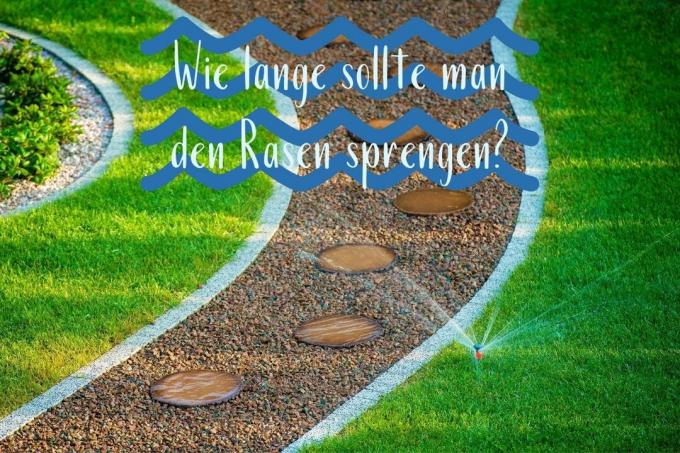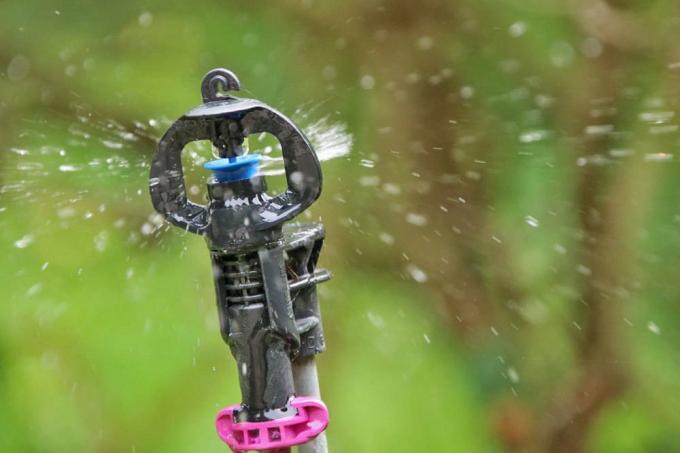
table of contents
- How often and for how long do you blow it up?
- The right amount of watering
- Be careful with freshly sown lawn
- Check the amount of water
- With the spade
- With rain gauge or flow meter
- With a glass of water
- Best time of day for watering
- frequently asked Questions
Anyone who values a vital, full green race must ensure optimal irrigation. You can go wrong with this. Watering the lawn regularly is a great option.
In a nutshell
- don't wait too long to blast the lawn
- Water supply at appropriate intervals, at the right time of day and in the right amount
- Proper irrigation ensures healthy growth and saves water
- Lawn weeds and moss can spread in poorly watered lawns
How often and for how long do you blow it up?
On a normal summer day, up to four liters of water evaporate per square meter of lawn. Since lawn grasses tend to have shallow roots, they hardly get enough water and wither. If you only water when the dryness damage is already visible, it is usually too late, because withered grasses do not recover.

- Regularly sprinkle the lawn as a preventive measure
- Sprinklers distribute water more evenly than the garden hose
- Better dose of water
- Sprinkle the lawn at longer intervals, but then plentifully
- Water only a little every day, not recommended
- Irrigate sandy soils for one to two hours every three to four days
- cannot store moisture as well
- everyone else once a week
- Soil should be moistened to a depth of about 15 cm
A so-called kick test can be used to determine whether it is necessary to pour. You step onto the lawn and if the grass doesn't come back up on its own, it's time to water.
Tip: If the grass is watered thoroughly every time, it stimulates the grass to form roots deep down. This in turn strengthens the grass and makes the lawn less susceptible to dry phases in the long term.
The right amount of watering
The amount of water required depends on the type of soil, temperature, humidity and the time of year. The warmer it is, the more water is evaporated and has to be supplied again. At temperatures of 20 degrees, the evaporation rate is less than two liters per square meter. If they rise to 20-25 degrees, there are already two to three liters and at temperatures of 25-30 degrees three to four liters. From 30 degrees more than five liters of water per square meter are evaporated.
Normal garden soil can usually not absorb more than ten liters per hour. On compacted surfaces, it may be advisable to blast in stages in order to gradually soften the surface. With loamy and clayey soils, 10 to 15 liters of water are calculated and with loose sandy soils up to 20 liters per square meter and irrigation process. This is the only way to optimally moisten the soil.

Be careful with freshly sown lawn
at freshly sown lawn seeds you should be a little more careful and not water too much. Since the seeds are not covered with soil, there is a risk that they will be washed away. This in turn makes it more difficult for a dense sward to form.
- Frequency and intensity of watering depends on the weather
- do not work with excessive water pressure
- The top centimeter of the soil should be evenly moist
- Irrigate for about 15 minutes a day for the first two weeks, depending on the weather
- in high heat twice a day
- Germination takes about one to three weeks
- then extend the watering intervals to one to three days
- Dense sward after eight to twelve weeks
Tip: Until the young grasses have developed enough roots, the gentler, oscillating sprinklers are particularly suitable for watering.
Check the amount of water
With the spade
Use the spade to dig out a square piece of the sod at an inconspicuous spot on the lawn and measure the moisture penetration on the basis of this.
With rain gauge or flow meter
As an alternative, you can use a standard rain gauge that can measure the amount of water per square meter. This can also be used to determine how long the sprinkler has to run for about 15 cm of moisture to penetrate. Or you can use a so-called flow meter, with which the amount of water can be dosed.
With a glass of water
Even a simple glass of water can show how deep the water has penetrated into the ground. Place it on the lawn to be watered and turn on the sprinkler. After a certain period of time, the glass is filled several centimeters with water and just as deeply seeped into the ground. The sprinkler can be turned off.

Best time of day for watering
At the latest when the first grasses hang limply, it is time to water. Regular watering of lawns is usually limited to the summer months and, in regions with little rainfall, also to spring. The right time to sprinkle the lawn is crucial, especially in periods of extreme drought.
- do not water during lunchtime
- Drops of water would have the effect of a burning glass
- also unsuitable evening hours
- Floor still too hot in the evening
- Most of the water would evaporate again immediately
- heavy and compacted soils remain too damp overnight
- This could result in mold growth
- best time in the early morning hours
- Soil cools down overnight, evaporation significantly less
Tip: In order to improve the air and water content, especially in heavy soils, it is advisable to aerate them regularly.
frequently asked Questions
Lawn grasses need enough water to develop optimally. However, if you water too much, the subsurface will become wet. This in turn is a good breeding ground for mosses and also attracts snails.
In the vicinity of trees or other larger trees, there is competition with the lawn for water absorption. The trees draw large amounts of water from the soil. Consequently, it makes sense to add an extra portion of water to the lawn.
If the grass has not yet completely withered, you can still try to save it. To do this, you should wait for a rainy season and then both mow and fertilize the lawn.



